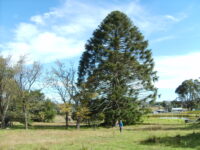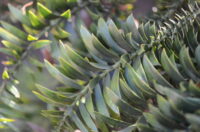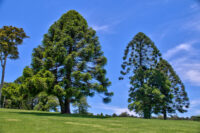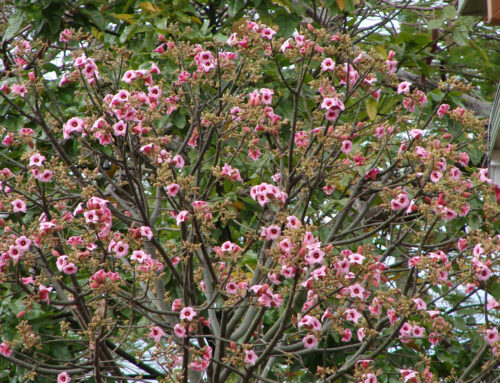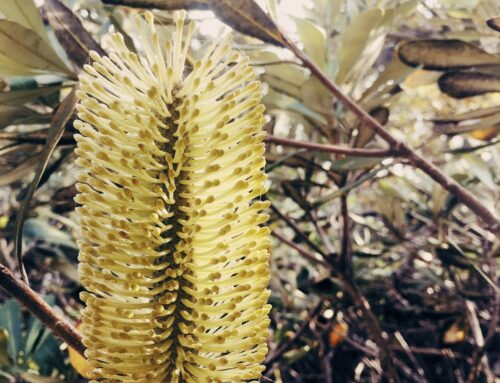Araucaria bidwillii, commonly known as the Bunya Pine or Bunya-bunya, is a tall, evergreen conifer native to southeastern Queensland in Australia.
Is notable for its large size, unique foliage, and significant cultural and ecological importance.
Taxonomy:
- Family: Araucariaceae
- Genus: Araucaria
Description:
- Growth: Typically, 30-45 meters, but can grow up to 50 meters. Straight, cylindrical trunk and a domed canopy. The bark is thick, rough, and dark gray to brown in colour.
- Leaves: Dark green, rigid, and scale-like, arranged in a dense spiral around the branches. Shorter, typically 2 to 5 cm long, and have a tough texture.
- Male Cones: Small, cylindrical, and appear in clusters. Typically, around 10 cm long.
- Female Cones: Large, spherical, and can reach up to 35 cm in diameter, weighing between 5 to 10 kilograms.
- Seed: The seeds are large, triangular, and edible. Encased in a tough outer shell and are about 2.5 to 4 cm long. When mature, the cones disintegrate to release the seeds, which fall to the ground.
Habitat and Distribution:
The Bunya Pine is native to the subtropical rainforests of southeastern Queensland, Australia. Prefers well-drained, fertile soils and is typically found at elevations between 300 to 1,200 meters. It can also grow in various other climates when cultivated.
Hosts: (included but not limited to)
- Sulphur-crested Cockatoo (Cacatua galerita): Feeds on the seeds, helps in seed dispersal by carrying seeds away from the tree.
- Australian King Parrot (Alisterus scapularis): Consumes the seeds and occasionally the foliage. Acts as a seed disperser and contributes to the regeneration of the Bunya Pine.
- Regent Bowerbird (Sericulus chrysocephalus): Uses the tree for foraging and nesting materials. Helps pollinate and seed dispersal through its feeding habits.
- Yellow-tailed Black Cockatoo (Calyptorhynchus funereus): Feeds on seeds and sometimes nests in the tree. Contributes to controlling wood-boring insect populations.
- Sugar Glider (Petaurus breviceps): Feeds on sap, insects, and seeds. Helps with pollination and seed dispersal; aids in controlling insect populations.
- Longhorn Beetles (Cerambycidae family): Larvae bore into the wood, helping with wood decomposition and nutrient cycling.
- Case Moths (Psychidae family): Larvae feed on the foliage or bark of the tree, causing leaf decomposition and nutrient cycling.
Ecology and Uses:
- Culinary Uses: The seeds of the Bunya Pine, commonly known as Bunya nuts, are a traditional food source. They are edible and can be consumed in various ways.
- Nutritional Value: Bunya nuts are rich in carbohydrates, proteins, and fats, making them a nutritious food source.
- Timber: The timber of the Bunya Pine is valued for its high quality. It is relatively soft, with a fine, even texture, making it easy to work with.
- Ornamental Tree: The Bunya Pine is cultivated as an ornamental tree in large gardens, parks, and botanical gardens worldwide due to its impressive size and distinctive appearance.
- Traditions: The Bunya Pine holds significant cultural importance for Indigenous Australians. Historically, large gatherings known as Bunya festivals were held during the nut harvesting season.
Links:
Araucaria bidwillii : Bunya Pine | Atlas of Living Australia (ala.org.au)

